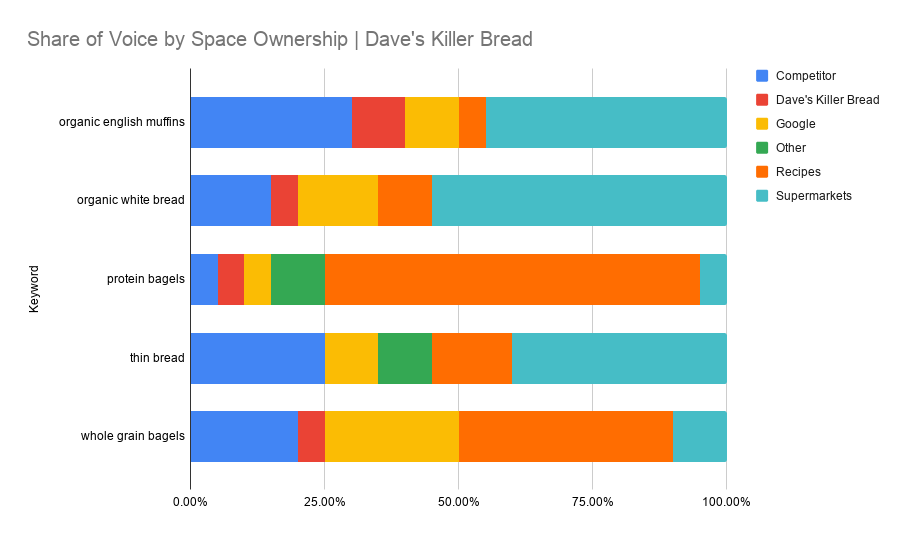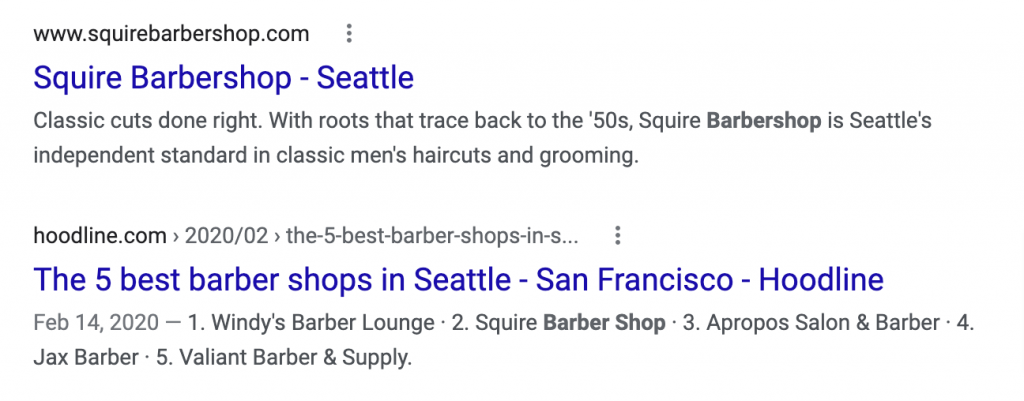Competition in the search engine results pages continues to grow and adapt to unforeseen changes. Sometimes, there’s a new competitor that feels like they came from nowhere. It can be somebody’s side project whose goal is to target and monetize the same traffic your site targets. Or, it can be a known competitor that chose to really invest in SEO all of a sudden. These changes can be hard to notice, especially if you’re only looking at your site’s SERP rankings and not your site’s Share of Voice.
What is Share of Voice?
Share of Voice is a quantification of a brand’s proportion out of the total possible opportunity for whatever is being measured, such as space ownership or traffic. It is common to hear about Share of Voice in all marketing channels, but in SEO, it is often referring to a brand’s opportunity in the search engine results page (SERP).
This is oversimplifying it, but Share of Voice is equivalent to finding what piece of that pie belongs to you. Is all of the pie yours? Or do you only get one bite of one slice?
There are two ways that Share of Voice can be measured: space ownership and possible traffic acquired from the SERP. Share of Voice by space ownership calculates how many out of the possible organic positions in a SERP belong to your brand. On the other hand, traffic Share of Voice is calculated by multiplying a keyword’s search volume by the average CTR of your website’s position on the SERP. Both are useful, but it is important to note that these measurements are insightful in nature, but they aren’t flawless.
There are multiple reasons why they aren’t TRUE measurements of Share of Voice. Since Google doesn’t give us all the data, we don’t know how many people click on ads or snippets, and we assume that everyone visiting a SERP clicks into a result. Although it can’t be 100% accurate in its measurement, Share of Voice continues to provide valuable insights.
SEO Use Cases for Share of Voice
There are multiple ways to gauge Share of Voice, but at the end of the day, your measurement of choice won’t matter unless you find the insight that will help your team meet their objectives.
If you are looking to understand changes in the SERP that your website is targeting, then I recommend Share of Voice by space ownership. It provides insights that can’t be visualized by relying on traffic Share of Voice, especially in times of unprecedented changes such as the COVID-19 pandemic.
Competition Landscape
Understanding who your competition is in the SERPs will help you narrow down the sites you look at while doing a Competitor Gap Analysis. Additionally, it helps you understand if your business competitors are the same as your search competitors. I’ve noticed that identifying if business competitors are the same as search competitors is something that does not come up when talking about the SERP. Although your business competitors want the traffic you’re targeting, they might not have the resources to invest in SEO.
That doesn’t mean you won’t have any competition; it just means your competition will have different objectives from yours.
For example, let’s say I own a barbershop in Seattle. My business competition is other barbershops, but in search, I have to compete with content and directory sites.
These types of competitors are often aggregator and directory sites, but they all change depending on the terms you are targeting. Depending on your business offering and keywords, you might have localized results that can impact your Share of Voice in specific locations, or you may have to compete with content editorials that are always wanting to be the most relevant.
Monitoring Changes in the SERP
SERPs change when unprecedented events happen. Many websites experienced that during the start of the COVID-19 pandemic. In my experience working with a client whose business is mainly an in-person service, the SERP for their core keywords noticed a higher Share of Voice for more news-related content that highlighted the local regulations and the impacts on their type of business.
With these unprecedented levels of searching, many SEO tools didn’t have reliable information on average search volumes of keywords. Often, these are calculated by how frequently people searched for particular terms in the last year. But when changes like these occur overnight, we can’t accurately measure how much of that traffic we own. We can measure how often our site continues to be visible in our core SERPs and what those changes are looking like. Is the SERP your site is targeting flooded with news, or are more directory sites now owning the SERPs you are focusing on? These quick insights can’t be visualized by relying on traffic Share of Voice, but they can be gained using a Share of Voice by space ownership.
How to Measure Your Share of Voice by Space Ownership
At this point, I hope I’ve convinced you to start thinking about the importance of Share of Voice by space ownership and how those insights can help your team meet your objectives. For me, the fun part is visualizing the data and presenting it to stakeholders, but you can’t visualize data unless you’ve analyzed it first.
Step 1: Identify a Group of Keywords
Select a group of keywords that are core to your business goals. These keywords can be the ones you get the highest clicks, revenue, or impressions from. Ideally, they would be keywords you know your site already ranks for in the first page or second page of the SERPs. I recommend keeping this list short, but how many keywords you identify depends on how many SERPs you want to keep an eye on. If you’re going to localize your SERPs, then the less, the better (I suggest no more than 10). If you’re only going to look at a national average, then have at it with more than 10.
To show you how to calculate Share of Voice by space ownership, I will use Dave’s Killer Bread as an example. Let’s say that their important terms are the following five keywords, and we want to know what their SOV is for each of them.
- organic English muffin
- organic white bread
- protein bagels
- thin bread
- whole grain bagels
Step 2: Use a Keyword Ranking Tool like STAT
Find a keyword ranking tool that can let you export ranking pages in a SERP, not just the position your domain ranks for in a specific keyword. I prefer to use STAT because it allows me to build reports that export the 20 positions in a SERP for a keyword. I’ll show you how I use STAT, but you can use your preferred tool.
After you’ve added your keywords to your preferred tool and have given it enough time to gather the ranking data for your site, you can start to analyze it.
Here’s how STAT will show you the keywords, and the ranking of your site:
![]()
If you are using STAT, you can then run a Top 20 Comparison (Google) report. Using the report from STAT I do my analysis on the rank positions. I’ll be ignoring base rank for this example.
Optional Step: Group Domains
I like to group similar domains together to have a better understanding of the type of sites mine is competing against. For instance, if I know that certain domains are aggregator or directory sites, I’ll group them together. I can also create a group of business competitors or news sites. It’s an optional step to compare your Share of Voice against categories of sites, and not just directly to domains.
If I were working on Dave’s Killer Bread, I would want to differentiate supermarkets, recipes, and competitors. STAT assigns snippets, carousel, local packs, and other SERP-related features to Google, so I’d keep Google as its own group.

Step 3: Create a Pivot Table of Ranking Domains
Using Excel or Google Sheets, I like to clean up the report from STAT, making sure it contains the ranking domains, the keywords, their position, and any additional information that will be helpful for insights.
I then use a pivot table to determine the percentage each domain or group of domains takes up. I do a count of the ranks or positions being tracked, and use the percentage of row total to identify the total allocation for each domain.

The pivot table is showing me how much space each group owns in the SERP for each keyword. Because I’m only looking at one SERP for each keyword and the Top 20 Positions of that SERP, I know that each position is equivalent to 5%. In the keyword “organic English muffins,” I know that the Share of Voice for Dave’s Killer Bread is 10%, so it owns two positions out of the 20 available. You’ll notice that the two groups with the highest SOV are Competitors and Supermarkets.
Step 4: Visualize Data Using Your Favorite Chart
The pivot table is already valuable, but it’s a bit harder to understand by just looking at the percentages. I prefer to use a stacked chart table to really show the difference in Share of Voice.

Visualizing the data is really fun and can drive home some important points. We can easily see that the keyword “protein bagels” is mainly owned by recipe sites. We also see that Dave’s Killer Bread isn’t showing up for “thin bread,” but the competition is. Identifying the Share of Voice for important terms can help their team prioritize where to optimize.
I prefer to update my Share of Voice reports monthly, and have a working connection between Google Sheets and Google Data Studio for a faster workflow and to keep data consistent.
Remember, the Insights Are for You; Adjust When Necessary.
I hope this was helpful for you. But just remember that every site is different and so should your approach be to Share of Voice. There are multiple things to consider, such as the number of SERPs, to group or not group domains, how many keywords to evaluate, and how often you want to update a Share of Voice report.
There are also many ways you can automate the process to help keep data consistent. The example I shared was a simplified version of the report, but depending on your business needs it can get really complex. However complex it may be, it can still be a useful tool.
Last but not least, this post focused on Share of Voice by space ownership, but using traffic can also provide important information to your team. The two can go hand in hand and help deliver a more comprehensive impression of your overall Share of Voice.
The post SEO Share of Voice by Space Ownership: What It Is and How to Measure It appeared first on Portent.



